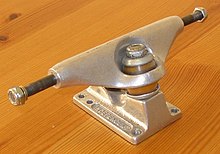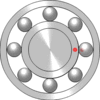It appears the first skateboards to reach public notice came out of the surfing craze of the early 1960s, just wooden boards with roller-skate wheels attached. The surfing group Jan and Dean even had a minor hit called "Sidewalk Surfing" in 1964. In time, it became a pastime for surfers when the waves were lax. By the mid 1980s skateboards were mass produced and sold throughout the United States.
A skateboard is propelled by pushing with one foot while the other remains on the board, or by pumping one's legs in structures such as a pool or half pipe. A skateboard can also be used by simply standing on the deck while on a downward slope and allowing gravity to propel the board and rider. If you ride with your right foot forward, you ride "goofy"; if you ride with your left foot forward, you ride "regular." If you are normally regular and are riding goofy, you are riding "switch," and vice versa.
Recently, electric skateboards have also appeared. These no longer require the propelling of the skateboard by means of the feet; rather an electric motor propels the board, fed by an electric battery.
There is no governing body that declares any regulations on what constitutes a skateboard or the parts from which it is assembled. Historically, the skateboard has conformed both to contemporary trends and to the ever evolving array of stunts performed by riders/users, who require a certain functionality from the board. Of course, the board shape depends largely upon its desired function. Longboards are a type of skateboard with a longer wheelbase and larger, softer wheels.
Parts
Descriptions of the following skateboard parts are the ones most prevalent in popular, modern forms of skateboarding. Many niche disciplines exist with exotic or alternative constructions and designs that fall outside of much of the descriptions listed. The usual parts to design a complete skateboard are the deck, trucks, wheels, bearings, hardware, and griptape.Deck
Most decks are constructed with a six to seven-ply cross-laminated layup of Canadian maple. Some of them have special materials that help to keep the deck from breaking: such as fiberglass, bamboo, resin, Kevlar, carbon fiber, aluminum, and plastic. Some decks made from maple ply are dyed to create various different coloured ply. Modern decks vary in size, but most are 7 to 10.5 inches wide. Wider decks can be used for greater stability when transition or ramp skating. Skateboard decks are usually between 28 and 33 inches long. The underside of the deck can be printed with a design by the manufacturer, blank, or decorated by any other means. On early year 2010 a European Company Gravitis introduced the proprietary asymmetric shape, with decentered twin tips to enhance the rider's stance.[citation needed]The longboard, a common variant of the skateboard, has a longer deck. This is mostly ridden down hills or by the beach to represent the riding of a wave in the ocean on a surfboard. This was created by two surfers; Ben Whatson and Jonny Drapper. One of the first deck companies was called "Drapped" taken from Jonny's second name. "Old school" boards (those made in the 1970s–80s or modern boards that mimic their shape) are generally wider and often have only one kicktail. Variants of the 1970s often have little or no concavity, whereas 1980s models have deeper concavities and steeper kicktails.
Grip tape, when applied to the top surface of a skateboard, gives a skater's feet grip on the deck. It is most often black but can come in a variety of colors including clear, allowing the top of the deck to be decorated. It has an adhesive back and a sandpaper-like top.
Trucks

An Independent brand skateboard truck
Skateboard trucks are manufactured in a number of different axle widths. In general an axle width should be chosen that is close to the width of the deck it will be used with.[1] For example, a 7.75" wide deck will usually be fitted with trucks that have axles between 7.5" wide and 8.0" wide. Trucks that are too wide can make doing tricks difficult and can cause the wheels to get in the way when the skateboard is being ridden. Trucks that are too small can be hard to maintain stability and can cause wheel bite to occur when turning.
Longboard specific trucks are a more recent development. A longboard truck has the king pin laid at a more obtuse angle (usually between 38 and 50 degrees[2]) to the deck, this gives a lesser degree of turning for the same tilt of the deck. This allows riders to go much faster while still maintaining stability and control.
Wheels
The wheels of a skateboard, usually made of polyurethane, come in many different sizes and shapes to suit different types of skating. Larger sizes like 54–85 mm roll faster, and also move more easily over cracks in pavement. Smaller sizes like 48–54 mm keep the board closer to the ground, require less force to accelerate and produce a lower center of gravity, but also make for a slower top speed. Wheels also are available in a variety of hardnesses usually measured on the Shore durometer "A" scale. Wheels range from the very soft (about Shore A 75) to the very hard (about Shore A 101). As the A scale stops at 100, any wheels labeled 101A or higher are harder, but do not use the appropriate durometer scale. Some wheel manufacturers now use the "B" or "D" scales, which have a larger and more accurate range of hardness. Modern street skaters prefer smaller wheels (usually 51–54 mm), as small wheels with lighter trucks can make tricks like kickflips and other flip tricks easier by keeping the center of gravity of the skateboard closer to the deck, thus making the deck easier to spin. Street wheels are often quite hard as this allows the wheels to slide easier on waxed surfaces for bluntslides and nose/tailslides. Vertical ramp or "vert" skating requires larger wheels (usually 55–65 mm), as it involves higher speeds. Vert wheels are also usually softer, allowing them to maintain high speed on ramps without sliding. Slalom skating requires even larger wheels (60–75 mm) to sustain the highest speeds possible. They also need to be soft and have better grip to make the tight and frequent turns in slalom racing. Even larger wheels are used in longboarding and downhill skateboarding. Sizes range from 65 mm to 100 mm. These extreme sizes of wheels almost always have cores of hard plastic that can be made thinner and lighter than a solid polyurethane wheel. They are often used by skateboard videographers as well, as the large soft wheels allow for smooth and easy movement over any terrain.
An Animation of the working principle for a ball bearing. N.B. The diagram shows an 8-balled-bearing whereas a skateboard bearing only has 7


Tidak ada komentar:
Posting Komentar